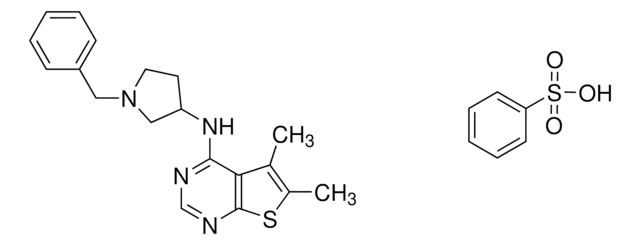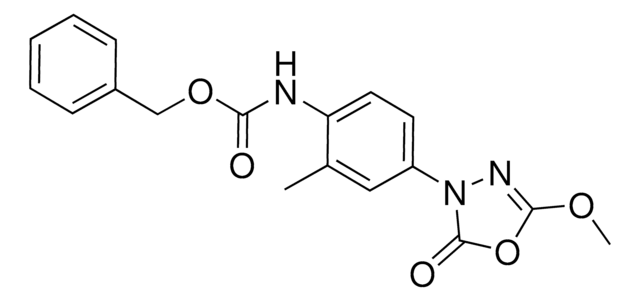おすすめの製品
アッセイ
≥97% (HPLC)
形状
powder
色
white to light brown
溶解性
DMSO: 5 mg/mL, clear (warmed)
保管温度
2-8°C
SMILES記法
O=C(C1CC1)N2CC[C@@H](CC(N3C4=CC=C(C5=CC=C(OC=C6)C6=C5)C=C4)=NNC3=O)C2
InChI
1S/C25H24N4O3/c30-24(18-1-2-18)28-11-9-16(15-28)13-23-26-27-25(31)29(23)21-6-3-17(4-7-21)19-5-8-22-20(14-19)10-12-32-22/h3-8,10,12,14,16,18H,1-2,9,11,13,15H2,(H,27,31)/t16-/m0/s1
InChI Key
AQTPWCUIYUOEMG-INIZCTEOSA-N
生物化学的/生理学的作用
GSK2194069 is a fatty acid synthase (FAS) inhibitor. GSK2194069 is a potent and specific inhibitor of the β-ketoacyl reductase (KR) activity of hFAS with an IC50 of 7.7 ± 4.1 nM for the overall hFAS reaction. FAS is upregulated in some cancers, including prostate cancer. GSK2194069 was found to inhibit tumour growth in prostate cancer C42b cell xenografts generated in Nod-SCID-gamma mice. Cellular FAS inhibition reduced cell growth were also demonstrated in non-small-cell lung (A549) cancer cell lines with an average EC50 of 15 ± 0.5 nM.
保管分類コード
11 - Combustible Solids
WGK
WGK 3
引火点(°F)
Not applicable
引火点(℃)
Not applicable
試験成績書(COA)
製品のロット番号・バッチ番号を入力して、試験成績書(COA) を検索できます。ロット番号・バッチ番号は、製品ラベルに「Lot」または「Batch」に続いて記載されています。
David Weigt et al.
Cell chemical biology, 26(9), 1322-1331 (2019-07-08)
Human cancers require fatty acid synthase (FASN)-dependent de novo long-chain fatty acid synthesis for proliferation. FASN is therefore an attractive drug target, but fast technologies for reliable label-free cellular compound profiling are lacking. Recently, MALDI-mass spectrometry (MALDI-MS) has emerged as
Myriam Cerezo-Magaña et al.
Molecular cancer research : MCR, 19(3), 528-540 (2020-12-09)
As an adaptive response to hypoxic stress, aggressive tumors rewire their metabolic phenotype into increased malignant behavior through extracellular lipid scavenging and storage in lipid droplets (LD). However, the underlying mechanisms and potential lipid source retrieved in the hypoxic tumor
ライフサイエンス、有機合成、材料科学、クロマトグラフィー、分析など、あらゆる分野の研究に経験のあるメンバーがおります。.
製品に関するお問い合わせはこちら(テクニカルサービス)








